Auto-Updating Copy | Automated Texts + Product Descriptions
How Automation Turns Content into Revenue Boosters in Only 4 Steps
Reading Time 9 mins | June 26, 2023 | Written by: Anne Geyer

"Content is one of the few aspects in which companies can still really distinguish themselves from competitors and stand out from the crowd." - Andreas Reuter, managing director of AX customer SSI Schäfer Shop, expressed it similarly once. Automating texts enables companies to meet the expectations of online users and also to stand out from the competition.
However, it's not just the situation in the competitive online market that speaks in favor of text automation!
Based on this, what happens when companies decide to use automated content creation and integrate it into their processes? What does text automation change in companies? What is their starting point, what problems will they have to solve? And where will they be at the end of the automation journey? In the following, we want to address all these questions and shed light on how AX customers evolve over time.
In collaboration with our customers, we have so far been able to identify four stages that they work through after the introduction of text automation. A spoiler in advance: it's not just text that goes from being a cost factor to a revenue driver - there's also a shift in thinking within content teams and across the business!
Before we get started, we have summarized the stages in an overview here:
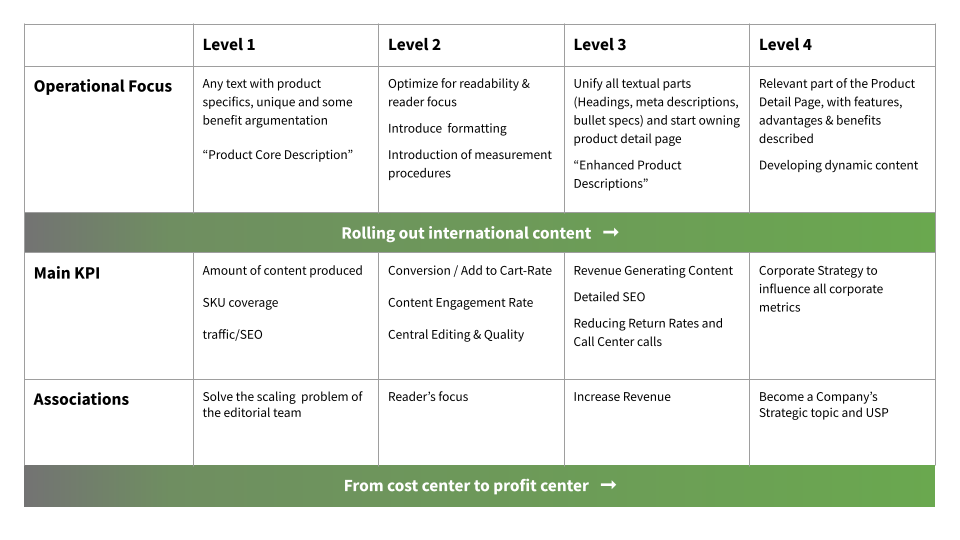
Stage 1: Text Changes from Cost Factor to Profit Center
Problem description
When companies contact AX Semantics, they usually want to tackle a content problem that cannot be solved manually. Not the least important point is often that the creation of texts costs too much and takes too long.
Status Quo
When a company implements text automation, it generally works like this: It starts with simple product descriptions that have a simple structure. The text contains only key data, such as category, manufacturer, simple formulations, etc. In short, the product is described solely in its core. The product, therefore, is only described in its essence. There are neither subheadings nor boldface to direct the reader's eye and help him grasp the offer, as the following example shows:

Objective
In stage 1, companies usually first set themselves the goal of adding text to all existing products or SKUs - as soon as possible. The major question here is whether and how editorial content can be scaled. The company finds the solution together with AX Semantics.
Developments in the company
Another major change in the company, that applies to all stages, is that editorial content is evolving from a cost factor to a revenue driver. As a result, often already in the first stage, but at the latest in stage 3, the internationalization of content is targeted.
| With AX Semantics, you can generate high-quality content in almost any language. More than 110 languages are supported in our Natural Language Generation software. Multilingual text generation is also possible. |
Stage 2: Reader Focus Becomes the Center of the Content Strategy
What happens in the content team?
The team also questions the source of the data on which the text generation is based. Often, product information is exported directly from a PIM system. Yet these also contain information that is of little interest to customers. The content team therefore develops an optimization process for the product data used in the texts, which they then also implement in stage 3.
Rethinking
The content team is shifting the focus more and more to customer needs and to the question: What do you absolutely want the customer to know about the product? In addition, there is the consideration of what the customer himself would like to learn about the product.
Moreover, the readability of the product information, i.e. the visual implementation, is playing an increasingly important role. To achieve this, the content team changes the structure of the texts. Subheadings help to structure the text, and highlighting, for example by bolding keywords, contributes to better readability.
The product description at level 2 will look like this:
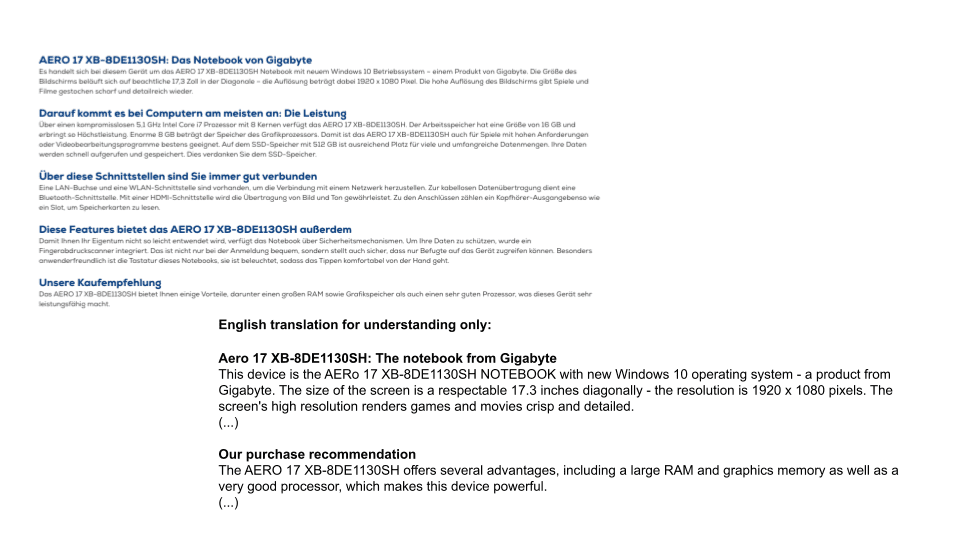
Measure success
The content team is also thinking about how to measure the success of the content created. After all, better texts also increase the conversion rate and the engagement rate.
Yet, for many content teams there is no insight into measurement tools (such as Google Analytics) to analyze the performance of the created content and optimize it accordingly. In order to measure the KPIs of their texts, many of our customers use the measurement methods of AX Semantics, as this gives the content team access to the KPIs that are important to them and gives them a comprehensive impression of the KPIs of the texts.
Also interesting: The Copywriter of Tomorrow - How Companies Transform Text Into a Revenue Driver Through A Copy
Stage 3: Improved Product Descriptions
At level 3, the content team optimizes both existing and newly developed processes. Product descriptions, for example, are further expanded and enriched with useful information. In addition to the core statements about the product, the text now delivers real added value for readers.
What is happening in the content team?
The content team is consequently shifting its focus from simply creating content to understanding copy as a strategic tool for the company. This reorientation is also reflected in the texts. The company's holistic objective becomes obvious in its content, as the strategic goals of the company merge and merge into the goals of the content team.
As a result, the team restructures and rethinks content. In doing so, they create higher and higher quality product descriptions and think of copy holistically, which includes, for example, SEO. In addition, the copywriters closely measure the success of the content and optimize their product pages accordingly.
For more reader-friendly content, bullet points are also used, for example. For search engine optimization, the team creates meta descriptions.
A product description will look like this, for example:
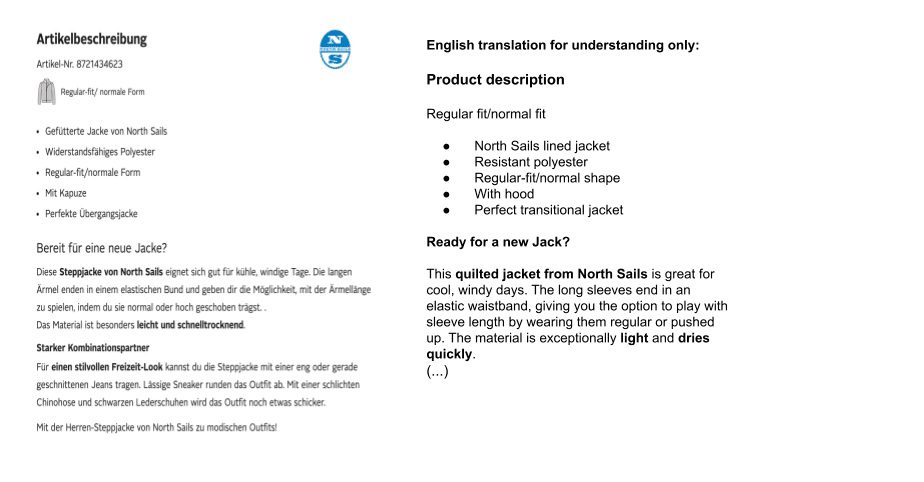
Goal
The new objectives for the content team to achieve are now also - in line with the company's holistic objective - to reduce return rates and customer service calls. The texts thus actively contribute to reducing costs and easing the burden on teams across the company. While at the same time, the content created by the content team increasingly contributes to revenue generation and increases sales, for example.
| With the user-friendly NLG software from AX Semantics, you'll be able to quickly generate all the content you need to stay ahead of the competition. |
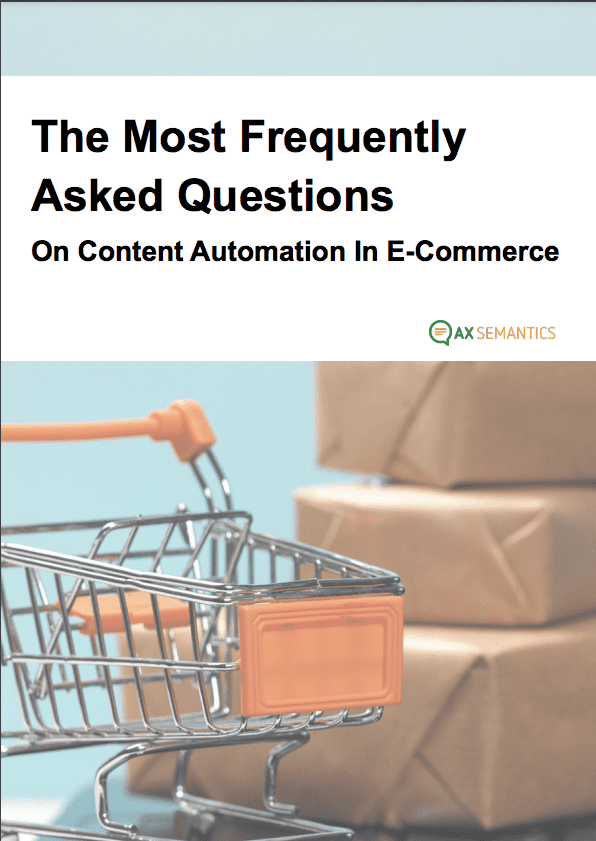
Open questions around automated content generation?
Download our free white paper that answers frequently asked questions around content automation and the AX software.
Stage 4: The Dynamic Content Team
Status Quo
The content team is now responsible for all content on the product detail pages. It also structures all the data that comes from the PIM and ensures that it is incorporated into the texts in a customer-friendly and reader-oriented manner. The content strategy is based on customer satisfaction and revenue generation. Both of these points guide the content team in their work. They constantly measure the success of the processes and the texts.
For the content team, the main focus is on customer benefits. The key focus of the content adjustments and optimizations is therefore the question of what advantages the products have for the customers and how they can best express and implement these advantages in the content.
What happens in the content team?
The content team is gradually making the texts more visually appealing. This is achieved, for example, by integrating color offsets as a structuring device. For conversion optimization, the team creates lists of advantages and disadvantages, formulates purchase recommendations, or integrates purchase requests into the product descriptions. This is what it looks like, for example:
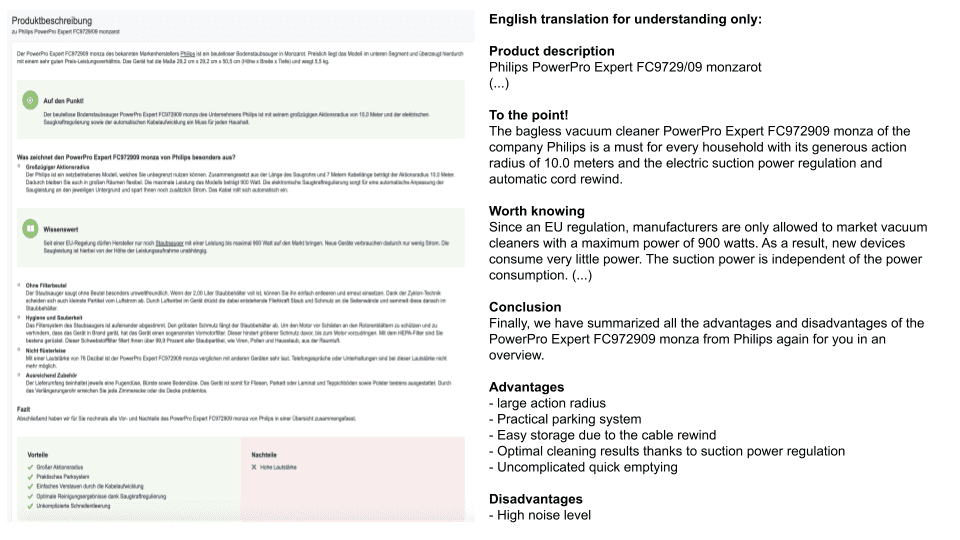
The dynamic content team
When we talk about a dynamic content team, we mean that the team modifies content depending on the situation and adapts it to the market. These are, for example, textual adjustments for Christmas holidays, Easter or hot summer days. The team scrutinizes the aforementioned buying arguments and adjusts them if necessary.
In stages 1 to 3, there has usually been an internationalization of the customer base. The dynamic content team also keeps this in mind and asks itself country- and culture-specific questions: Are different holidays to be planned in other countries than in this country? In which languages should content be geared towards Easter and Christmas - and in which not? What cultural adaptations need to be taken into account in general? - The content team ensures that the content remains dynamic and always addresses customers in an up-to-date and individual way.
| AX Semantics Personalized Commerce designs, tests and optimizes the best product page to convert each individual customer - automated and scalable. |
Sales driver text
The company strategy is the common thread that guides all actions, adjustments and team strategies. The content team bases its work on the KPIs, and the success of the texts becomes clear on the basis of the key figures.
As a result, the management's perception of the content and the content team has also changed. The content team and text automation are understood as a strategic control instrument for revenue generation. Content is no longer a cost or even a loss-leader, but a key revenue driver as well as a differentiator from the competition.
